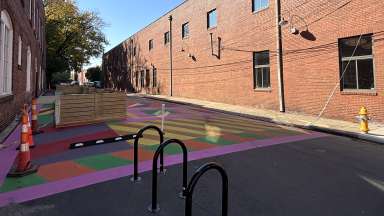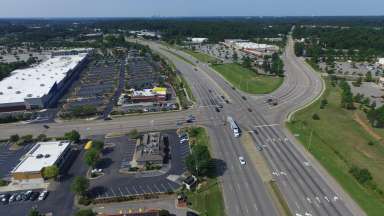Jump To:
A TIG is an additional economic development tool in the City’s toolkit. It is used by cities and counties to expand employment and economic development opportunities and to deliver needed public infrastructure and other benefits by providing development projects with a financial reimbursement grant equal to a set percentage of new property tax revenues created by the project for a set period of time. The infrastructure and facilities must be beyond what is customary for a similar development project or required by code.

Pedestrian Way on Fayetteville Street Raleigh
Purpose of a TIG
- Uses public-private partnerships to create needed infrastructure and public benefits.
- Provides an opportunity for the City to influence the development project.
- Encourages development, jobs, and services in areas of need.
Tax Increment Grant Explained
Benefits
To enter into a TIG agreement, both the developer and the City need to see a benefit from the arrangement.
| Group | Benefits |
|---|---|
| City of Raleigh | For the City, the enhanced infrastructure and community benefits are the goal. |
| Developer | For the developer, the infrastructure, while benefiting the public, may also enhance the value of the overall project. |
| Public | Parks and transit infrastructure are examples of investments that have benefit both the new development and the public who can make use of the facility |
Overall benefits
The social value to the City, the financial value to the developer, and the magnitude of the TIG must be balanced as part of the agreement.
- Incorporating public improvements in adopted plans into private projects with a TIG could expedite delivery of those improvements.
- Construction of the public infrastructure could occur at the same time as project construction, saving costs and minimizing disruption.
- The City is not taking on any debt to add priority infrastructure or other benefits that are commonly listed in approved plans.
- The development generates new and additional property tax revenue for the City with only a portion of the new revenue reimbursed to the developer as part of the TIG. The increased tax revenues to the City continue after the TIG payment period ends.
Eligible Types of Projects
Examples could include greenway connections, pedestrian improvement, transit infrastructure, environmentally advanced stormwater features, and so on; or facilities such as a park, arts venue, recreation facilities, etc. Combined with these could be other benefits to the community, such as job training or development of affordable housing.
As part of a project qualifying for a TIG, a developer may obligate itself to construct a certain percentage or number of affordable housing units within the project. A TIG may increase funding available to a developer to support such affordable housing either through direct assistance or by reducing a developer’s cost burdens for infrastructure within the project.
How to Apply for a TIG
There is not yet a standard application form for a Tax Increment Grant. Instead, those seeking a TIG are asked to start the process by submitting a letter of interest to the contact person listed below:
Ken Bowers, Planning & Development
919-996-2633
Ken.bowers@raleighnc.gov
The letter of interest should contain enough specifics to determine whether the proposal is likely to meet the terms of the adopted Tax Increment Grant Policy. Potential applicants should review the policy prior to submitting a letter of interest.
Letter of Interest Contents
- A description of the proposed development project, including the estimated increase in tax value.
- A description of the proposed public infrastructure/facilities and any other public benefits, emphasizing the benefits that accrue to the general community as opposed to the occupants and patrons of the development.
- An estimate of the cost of the infrastructure/facilities and benefits, and the portion of this cost to be funded through the Tax Increment Grant.
- Relationship of the proposed project and public improvement to adopted plans, including the City’s 2030 Comprehensive Plan, Area Plans, and the Strategic Plan. If the proposed public improvements are not part of a City-Council adopted plan, the TIG policy requires a public engagement process to obtain input on the project prior to any TIG agreement.
- Whether the developer will seek participation by Wake County in addition to the City of Raleigh.
Next Steps
Following the receipt of the letter of interest, City staff will make a preliminary determination as to whether the proposal can meet the parameters of the TIG Policy. If yes, staff will schedule a meeting with the applicant to discuss the proposal in more detail. Staff attendance at the meeting will be based on the specifics of the proposal, such as whether the infrastructure is best described as a park or greenway project, or a transportation project, stormwater, or something else.
If the public benefits appear compelling and commensurate with the value of the grant, staff will make a recommendation to the City Manager, who in turn will decide whether to place the application before City Council. Staff will post project-specific information about the proposed TIG on the City’s website and will notify the public of the proposal. If the proposed infrastructure is not in an adopted plan, or if significant public benefits beyond the infrastructure are proposed, a more intensive public engagement process may be required. Following a period of public engagement, and if authorized by City Council, staff will begin the process of negotiating the final TIG agreement with the applicant. The final agreement shall be subject to Council approval following a public hearing.
How Funding Works
The TIG is provided on a reimbursement basis only and based on a percentage of new, net incremental property taxes generated from the project within a defined area. All property taxes for the project are paid by the developer first and contractual performance verified; then the established percentage of the incremental property tax is paid to the developer for an approved number of years to cover the costs of the improvements. All terms, the grant amount and other requirements are spelled out in an agreement and voted on by Council after a public hearing.
The funding percentages and terms of the City’s TIG are listed below. The developer is not guaranteed the maximum percentage or term. The higher grant percentage and years for priority economic development areas helps encourage economic development in all parts of the City. The actual percentage and term will be determined by the City based on the specific benefits of a proposed project.
|
Priority Area for |
Net Incremental |
Length of Time |
|---|---|---|
|
Outside |
Up to 50% |
Up to 10 years |
|
Inside |
Up to 75% |
Up to 15 years |
Limit or cap on the total number of TIGs that the City could approve
The City’s financial commitment for all approved projects may not exceed 2% of the City’s annual property tax levy in any given year. For the 2020-2021 fiscal year, the total limit is $5.1 million. The capacity limit will be evaluated annually by City staff and is expected to change based on the City’s tax rate and total assessed property values.
Common Questions
Does every development project get a TIG?
Like other Economic Development tools, the TIG does not fit every development project. The TIG policy lists project requirements for eligibility. Development projects are not guaranteed a TIG. Projects are reviewed by City staff and the City Council on a case-by-case basis. The project itself and public outcome desired of the project will help determine eligibility for a TIG.
Does a TIG put the City at risk?
No. Under a TIG, the developer, not the City, assumes the risk to design and build the public infrastructure, facilities or benefit programs supported by the grant. The City does not borrow money to pay for the project. No grant payments will be made by the City until performance by the developer is verified and all property taxes associated with the project have been paid.
Is the TIG a tax break?
With a TIG, the developer is still paying the full amount of property tax associated with the development. There are no tax breaks or tax reductions for the developer. This is a public-private partnership generating benefits from a portion of new property tax dollars.
Can a TIG benefit the community?
Yes, it must! For the City to participate in a TIG agreement, the project must demonstrate measurable benefits to the public. The benefits may include jobs, infrastructure, and/or affordable housing. The developer must show that the proposed project is in alignment with City priorities and goals including the City’s Strategic Plan.






